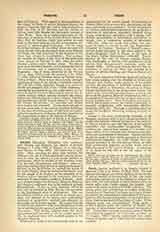

Ferstel, HEINRICH, FREIHERR VON, architect; with Hansen and Schmidt, the creator of modern Vienna; b. July 7, 1828, at Vienna; d. at Grinzing, near Vienna, July 14, 1883. His father was a bank-clerk. After wavering for some time between the different arts, all of which possessed a strong attraction for him, the talented youth finally, decided on architecture, which he studied at the Academy under Van der Nall, Siccardsburg, and Rosner. After several years during which he was in disrepute because of his part in the Revolution, he entered the atelier of his uncle, Stache, where he worked at the votive altar for the chapel of St. Barbara in the cathedral of St. Stephen and cooperated in the restoration and construction of many castles, chiefly in Bohemia. Jourrltys of some length into Germany, Belgium, Holland, and England confirmed him in his tendency towards Romanticism. It was in Italy, however, where he was sent as a bursar in 1854, that he was converted to the Renaissance style of architecture. This was thenceforth his ideal, not because of its titanic grandeur, but because of its beauty and symmetrical harmony of proportion, realized preeminently in Bramante, his favorite master. He turned from the simplicity and restraint of the Late Renaissance to the use of polychromy by means of graffito decoration and terra-cotta. This device, adapted from the Early Renaissance and intended to convey a fuller sense of life, he employed later with marked success in the Austrian Museum.
While still in Italy he was awarded the prize in the competition for the votive church (Votivkirche) of Vienna (1855) over seventy-four contestants, for the most part celebrated architects. In this masterpiece of modern ecclesiastical architecture he produced a structure of marvellous symmetry designed along strong architectural principles, with a simple, well-defined ground-plan, a harmonious correlation of details, and a sumptuous scheme of decoration (1856-79). After his death this edifice was proposed by Sykes as a model for the new Westminster cathedral in London. Another of Ferstel’s monumental works belonging to the same period is the Austro-Hungarian bank in Vienna, in the style of the Early Italian Renaissance (1856-60) The expansion of the city of Vienna enabled Ferstel, with Eitelberger, to develop civic architecture along artistic lines (burgomaster’s residence, stock exchange, 1859). At the same time he had also the opportunity of putting his ideas into practice in a number of private dwellings and villas at Brunn and Vienna.
The more important buildings designed during his later years, passing over the churches at Brann and Sehonau near Teplitz, really products of his earlier activity, are the palace of Archduke Ludwig Victor, his winter palace at Klessheim, the palace of Prince Johann Liechtenstein in the Rossau near Vienna, the palace of the Austro-Hungarian Lloyd’s, at Triest, but above all the Austrian Museum (completed in 1871), a masterpiece of interior economy of space with its imposing arcaded court. Next to his civic and ecclesiastical masterpieces comes the Vienna University, of masterly construction with wonderfully effective stairways (1871-84). Through a technical error his design for the Berlin Reichstag building received no award.
Ferstel is the most distinctively Viennese of all Viennese architects; able to give a structure beauty of design and harmony without prejudice to the purpose it was to subserve, and this because of his artistic versatility and inexhaustible imagination. These qualities also assured him success as a teacher, and were evident in his memoirs and numerous treatises, which are masterpieces of clearness. Special mention should be made of those which appeared in Forster’s architectural magazine. In 1866 Ferstel was appointed professor at the Polytechnic School, in 1871 chief government inspector of public works and in 1879 was raised to the rank of Freiherr. At the time of his death he was still in the full vigour of his strength.
JOSEPH SAUER

